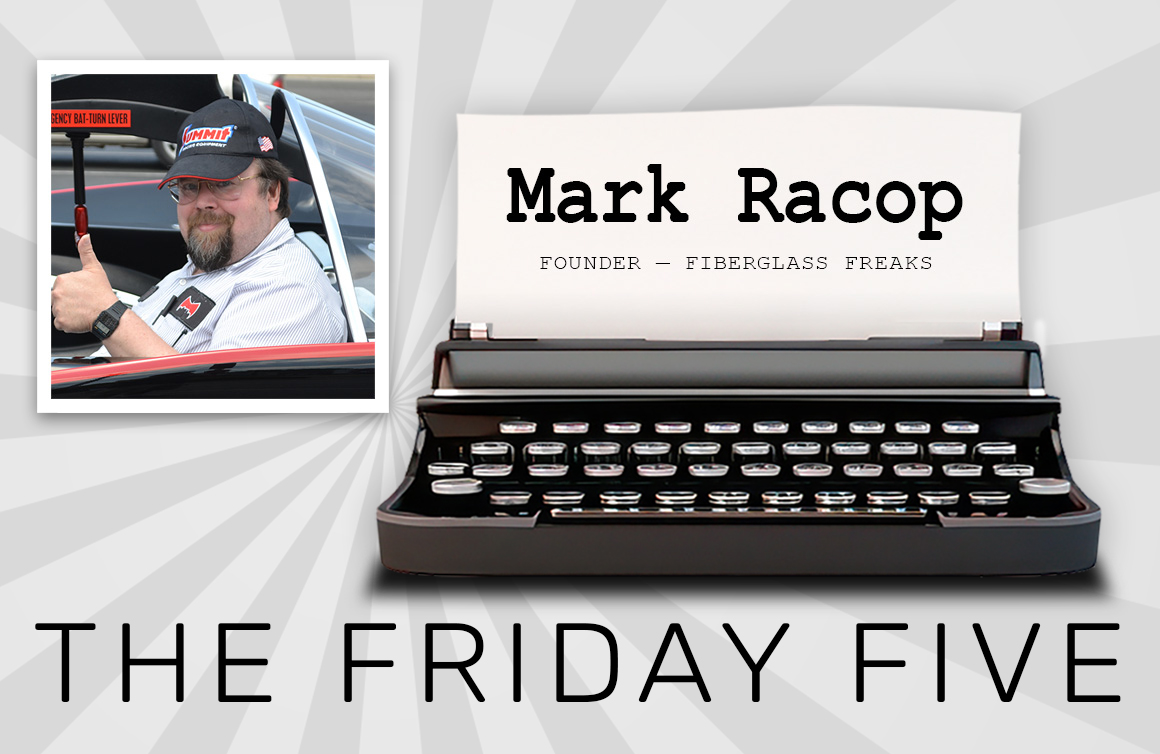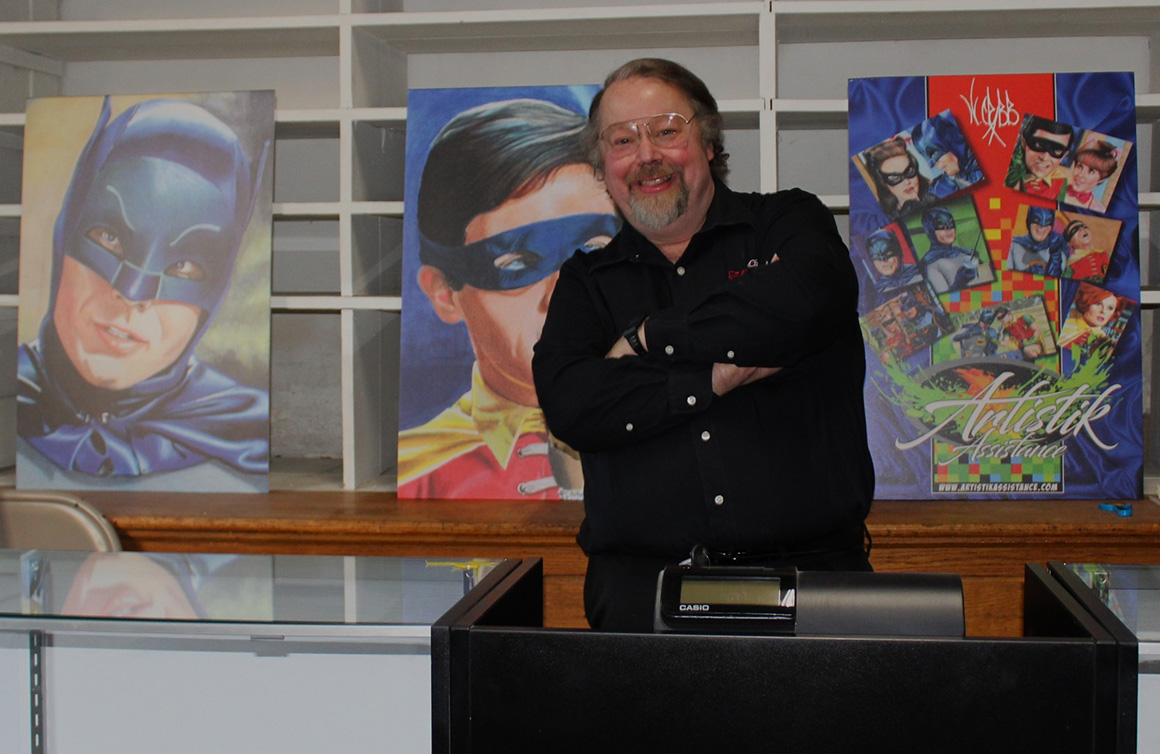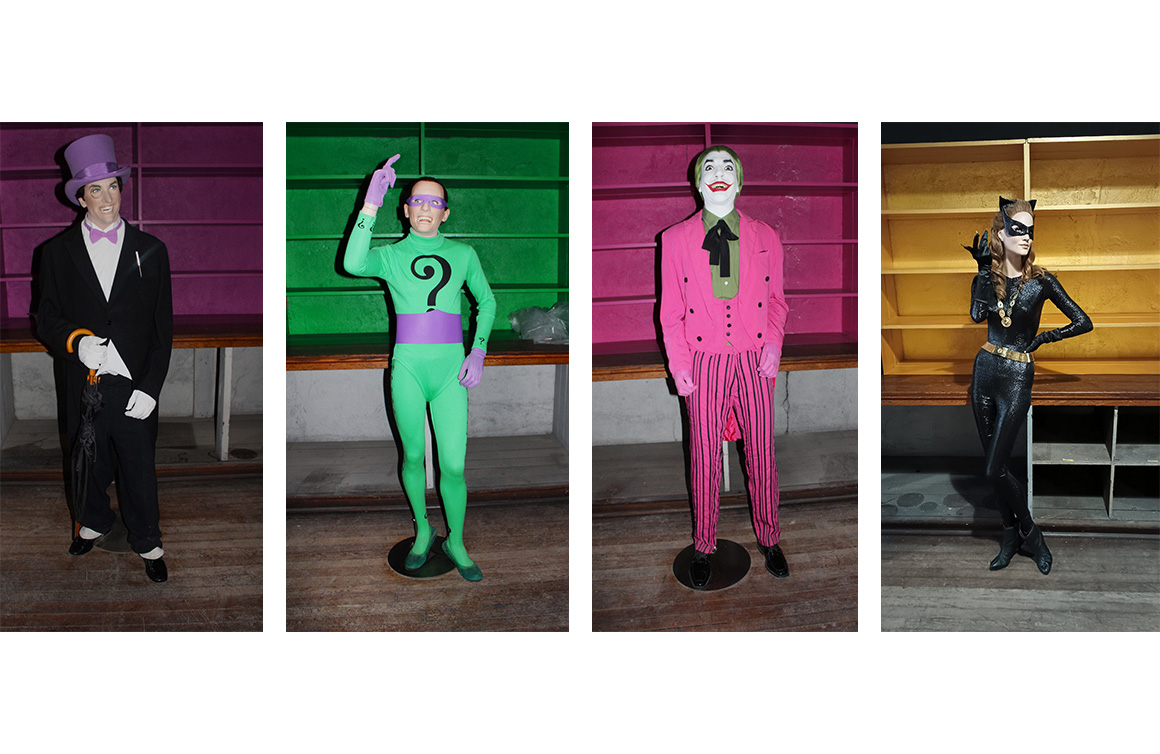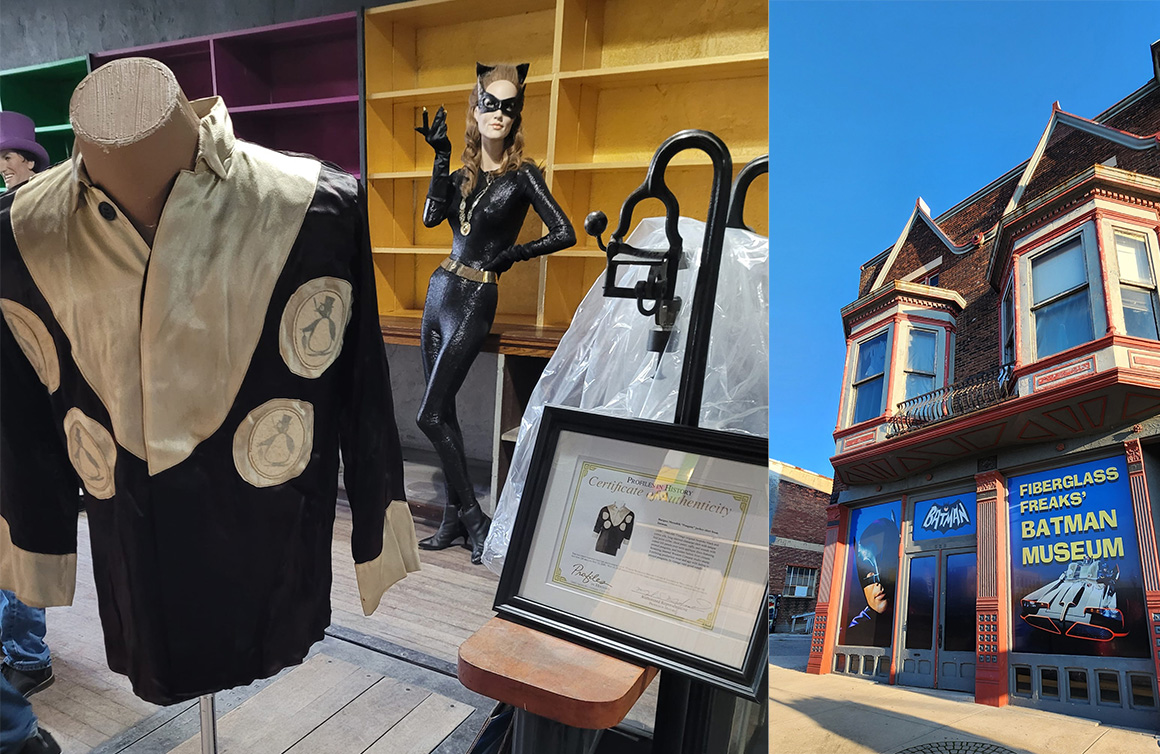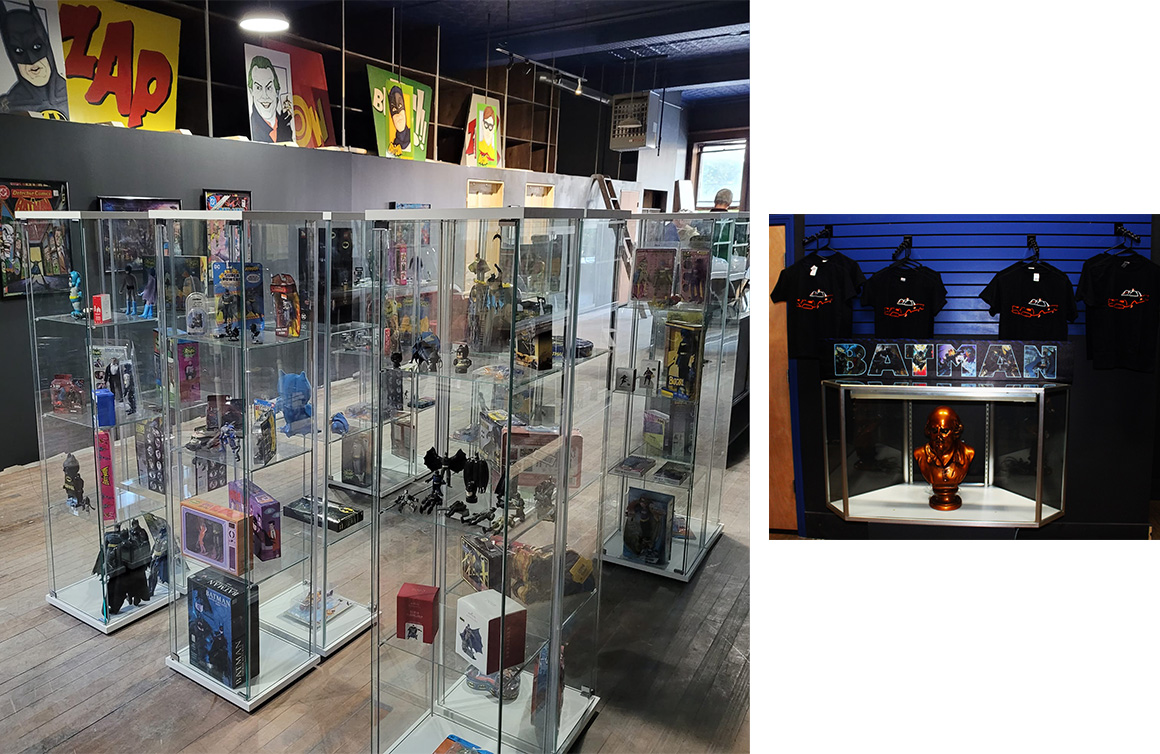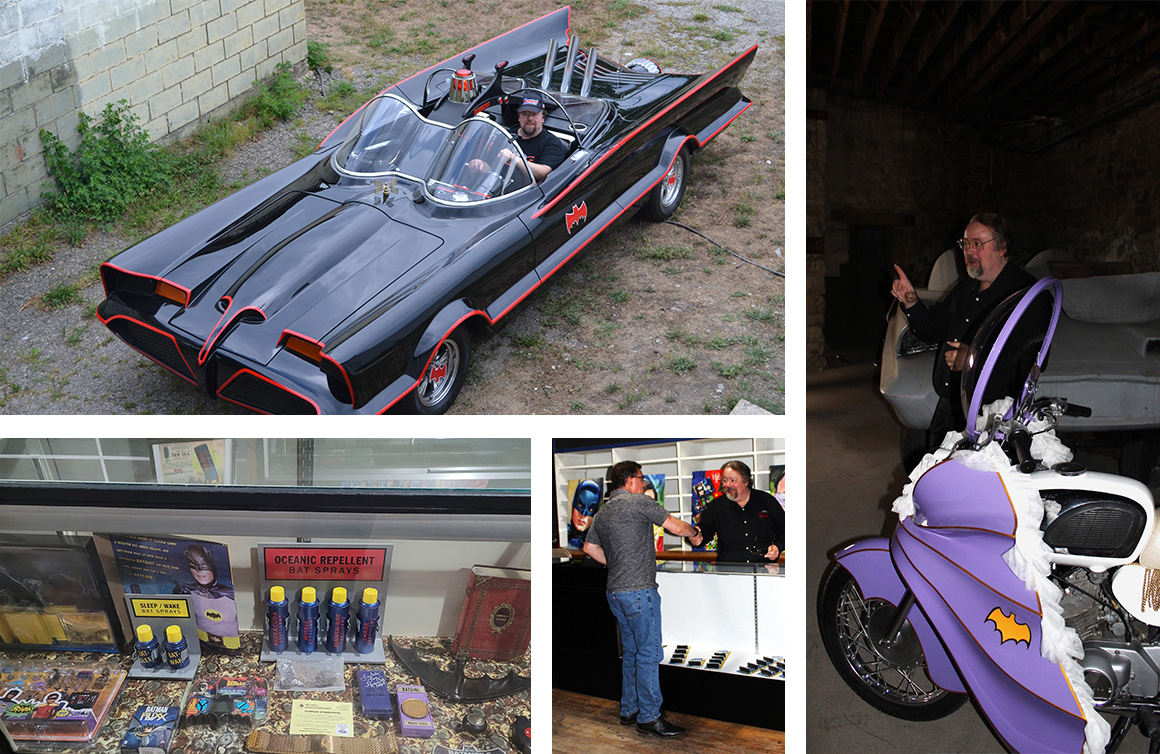What first captured your attention about Batman and how has that enthusiasm sustained itself into your adulthood?
I was two years old in 1967, during the second season of the Batman television show. I fell in love with the music, the action, the colour, the costumes, everything about it — but especially the Batmobile.
In the very first episode I saw, Joker was about to stamp Robin into a comic book. That particular episode left an indelible impression and I remember it like it was yesterday. There are people who think it isn’t possible to remember something from when you were two years old but my mom and dad can tell you that I could! My second birthday involved a Batman cake, if that tells you anything. From that point on, birthday parties — whether it was mine or my brother’s — involved capes as well as cakes. I said I wanted to grow up to be Batman, and I wanted to drive the Batmobile, the coolest car on the planet.
I was 11 years old when my dad took me to the antique auto museum in Chicago. There, I got to see my first full-scale Batmobile. Up to that point, I was only playing with the little Corgi miniature, the 5.5-inch diecast car from England. To see that car full-scale was amazing. As I later found out, it was the number-four dragster that George Barris built — the fourth of the four Batmobiles that he made. This car was on drag strips all across the country. I didn’t know that at the time; I had no idea that there were duplicates made. I bought the 8″ x 10″ photo of the number one car and, as I looked at it and made comparisons, I realized that it couldn’t be the number one car, it had to be a replica. Even at age 11 I knew that.
So I made the decision that not only was I going to own a Batmobile someday, I was going to build it. I had no automotive experience, no automotive tools, and no clue how to build a car. My dad wasn’t in the automotive business, he was a school administrator. So, in 1983, five crazy 17-year-old kids converted a ’74 Monte Carlo into my first Batmobile.
The Batman show was so much fun. I enjoyed every every aspect of it. You see the twinkle in the cast members’ eyes as they are getting to be over the top — the villains in particular. Burgess Meredith as Penguin, Cesar Romero as Joker, Julie Newmar as Catwoman, and Victor Buono as King Tut were just chewing up the scenery. You could tell they were having the time of their lives.
My enthusiasm for the Batman series faded a tiny bit when I was 12 or 13. That was one of the things that the producer, Bill Dozier, said that they had a problem with because that was a transitional age where kids knew that the series wasn’t quite straight action-adventure, but they didn’t quite get the jokes yet. During that transition phase, I still appreciated it but I didn’t go whole-hog into it. I also got distracted by Star Wars in 1977 and really went full bore into that and did costumed appearances at movie theatres all across the US.
I watched Star Wars and wanted to become a filmmaker — I thought, if a movie can make a person feel this good, I want to make movies. So at age 12,the path had already been chosen for one of my five future jobs. In high school, I made two Batman fan films and I majored in filmmaking in college. For the first two fan films, we did not have a Batmobile. I was gearing up to do my third fan film in college and I wanted the ultimate prop. Necessity is the mother of invention — we had costumes, we built props, we built sets — how hard could it be to build a car? Turns out there’s a reason why Ford only built one Lincoln Futura in 1955 — it’s really hard.
Whenever you’re talking with anybody about Batman ’66, there’s an instant camaraderie because it’s usually the same age group — somewhere between 45 and 65 years old — and it’s an absolute blast to talk about the show. Did they discover it when they were young or as an adult? Did they know as a kid that there was a comedic element to it? I certainly did not. As a kid, it was straight action adventure and I barely noticed the “BAM!”, “BIFF!”, “POW!” To rediscover it as an adult was to appreciate it on a whole different level. It was so neat to see how much fun they had, the production value, how many stars made appearances — through adult eyes, it was like watching a completely different show.

Fiberglass Freaks grew from your personal pursuit to create a Batmobile and evolved to become a thriving business where you and your team now build Batmobiles for clients. What is it about that specific version of the Batmobile that continues to captivate people?
The ’66 Batmobile continues to attract our attention because it still looks futuristic.
I was talking with Adam West about that at one of the conventions. He said that the Batmobile was iconic in 1955 as the Futura. it was iconic in ’65 when George Barris modified it into the Batmobile, and it’s still iconic today because it still looks like something that could happen in the future. It’s the giant bubbles for the cockpit, the giant fins look like it’s science fiction. And then of course being atomic powered and all these kinds of things. It’s big and exciting for those of us who grew up in the space age — we were rocket obsessed back in the Apollo era. It all dovetails together, and it still attracts kids today.
We were at a convention where there was a Tumbler beside our ’66 Batmobile. The kids would walk past the Tumbler, saying the Tumbler’s nice but here’s the real Batmobile. What do you make of that? The Tumbler should have been their car and yet they are still looking at the ’66. Even people who have never seen the television show seem to gravitate towards the ’66.
I was standing on bleachers at a car show looking down at one of my ’66s alongside a Tumbler, and the ’89 Batmobile. I think it finally hit me as I looked at all three cars as to why the ’66 standouts compared to the other two. The ’66 is the only Batmobile that looks finished. It has a gloss-black paint job, pinstriping, chrome — it has everything you would ever want on a car for a serious Batman. From an automotive perspective, it looks like it’s complete, whereas the others look like they’re in black primer and need to be finished.
When I see one of our cars when they’re in primer, it’s not as exciting seeing it after it’s painted, especially if it’s lowered down onto its Radar wheels just like the original car had back in 1966. I still get butterflies to see it, even 20 years later.
Here is a little bit of Fiberglass Freaks history and how we transitioned from this being a hobby to it being a business. In 2003, we were doing a mild refurbishment of my first car, the one I built in 1983. I had a guy who was helping me who was a professional in the automotive business. I shared with him that I had always toyed with the idea of going into business selling Batmobile replicas. He responded by saying that there can’t possibly be a market. I said, I think you’d be surprised. Then we went to Auburn, Indiana for one of the cruise auctions. They were auctioning one of the Bob Butts Batmobile replicas. This car reached $140,000, which was a lot of money back then. But, it did not meet the reserve and did not sell. My business partner and I looked at each other, and his jaw hit the floor. He said, “Oh, we’re definitely doing this.” And I said, “Yes, absolutely.”
September 1 of 2003 was the beginning of Fiberglass Freaks. We bought a Lincoln Town Car, chopped off the Lincoln, kept only the chassis and the floor pan, and started hand-sculpting a yellow urethane foam version of the body. Then something magical happened. You know the slogan “Only find it on eBay”? They’re not kidding. The Futura was a one-of-a-kind concept car. There was a fan of the Futura named Marty Martino and he is a famous automobile sculptor who does concept car replicas. He made a sculpture of the Futura to be able to pop molds from so he can, make his own Futura replica. He put that sculpture up on eBay and I bought it.
Three months later, we had constructed a body that was pretty good and we were able to cast a Futura mold and body. And then just like what George Barris did to the original metal Futura, we were doing to the fiberglass body to create our first Batmobile. And who would have ever thought it would have turned into this?
DC Comics sent a spy to my shop pretending to be a customer. The spy reported back that if they were ever going to license anybody that I’m the guy. The reasons that they gave were the level of quality and accuracy in my replicas. That’s really the niche — that’s how I got into the Batmobile business. Nobody else was doing either one. They also thought that I would be a good ambassador for DC Comics and for the television show. So, they chose me for the licensing. It transformed everything about the business. In 2010, we became licensed by DC Comics and they haven’t licensed any other vehicle for public purchase.
I’m a custodian to something really special and that continues to drive me to produce product of the absolute top level. We never sit on our laurels and have never stopped researching and developing.

Tell us about Fiberglass Freaks’ Batman Museum and how that idea came about.
It was about 10 years ago. I went to the bank to talk about possibly doing a line of credit. I only get paid about six times a year with with the cars, so it is either feast or famine. In those famine times, it’s kind of nice to have just that little extra cushion. The bank suggested that I needed an actual showroom for the cars instead of the Batmobile factory, where you’ve got a quarter-inch of dust on everything you need. That planted the seed.
A second seed was planted as people came into my office and saw my Batman collectibles on display. I had them jam-packed onto bookshelves, in boxes, and things like that. They thought that I needed to create a museum. The combination of both of those comments got got the idea percolating.
About seven years ago, I really started in earnest to look for a building for the museum. About four-and-a-half years ago, I found that building. The museum is coming along really well; it houses my personal collection and there’s a tiny bit borrowed from one of my Bat-buddies. I expect from time to time that there will be other things that are borrowed or rented. I think by the end of November, we will be done with our part. The next questions are about what the state and city will require as modifications.
The museum takes visitors through the Batman timeline. It shows everything from the 1939 serials, the television show, and then of course the current Batman and LEGO Batman movies. We’ve recreated a lot of the familiar elements like the blinking Bat Phone in the Wayne Manor study. When the Shakespeare bust is pushed back, it triggers a sliding bookcase where you step inside and hold the Bat Pole. We have documentaries playing in a theatre about the television series, the Batmobile, the Futura, Fiberglass Freaks, and Logansport, Indiana transportation history. Logansport was a major railroad hub in the late 1800s and part of the Pennsylvania Railroad.
We have a Rogues Gallery where people can climb to meet a friend that is popping out for a window cameo. If you remember on the show, all of that was shot with the camera turned sideways — they were really walking horizontally.
Then there’s a series of glass cases filled with toys and memorabilia. We have a screen-used Penguin jacket from the third season of the series. I also have the Riddler costume from the reunion movie called Back to the Batcave. There are several autographed items like Julie Newmar’s Catwoman belt and Yvonne Craig’s Bat Girl walkie talkie. They’re not screen-used but they are exact matches to what was used on the show. Then there are statues of Joker, Riddler, Penguin, and Catwoman that a person can stand right next to for photo ops and selfies.
We built a Batcave downstairs where I have my first Batmobile on display with memorabilia from building that first car. We’ve recreated the Atomic Pile on the back wall. The Bat Poles are there for more photo opportunities along with statues of Batman and Robin. We have Barbara Gordon’s Batcycle and the Batman Batcycle on display along with the Futura sculpture that I bought on eBay. Then it’s back upstairs to the gift shop.
My goal for the museum is for people to walk in and see their Batman. I’d be happy with that.
We expect the museum to open in late January or early February of 2024.

What has surprised you about the process of establishing a museum?
The building is fairly narrow so it’s a little tough to get the scale of things right, especially with the Batcave and things like the Atomic Pile.
I pretty much knew going in that the surprise would be the city kind of changing its mind on whether or not a museum was considered a “change of use” for the building.
Nobody’s ever done anything quite like this museum before — every single part of it’s a challenge. There have been areas of museums that are similar where they tried to make a facsimile of certain elements but nobody’s ever tried to make one that’s close to what the original had in it, including Batcave equipment that looks like using vintage equipment to construct exact replicas of the the two spinning radar discs that were the lunar and terrestrial scanners and the back computer itself.
Those are some of the research projects that my friend James Cawley is doing. He’s building them for me. He’s the guy who does the Star Trek original set tours in Ticonderoga. I highly recommend going to it if you haven’t been yet, it’s an exact replica of Stage Nine with all of the Enterprise sets — it’s absolutely fantastic. So immersive. And, that was my goal here with the museum — once you step into the Batcave I want it to be a totally immersive where you feel like you’re in the actual Batcave.
The other challenge was COVID, of course. That really knocked the wind out of our sails just as it did for everybody on the planet. Our main foreman left the project, which was a huge blow to us. I had to get everybody else on board to bring them up to speed as to the vision and where we were going with the museum. The project took about a year and a half longer than I expected.
But, everything else has gone pretty well. I was happily surprised that once I got into the mode of populating the glass display cases, within 24 hours, it changed overnight.
The delay allowed me to accomplish things that I was going to hold off. I’m glad we’re able to get them all done ahead of time.

It’s sometimes said that if a person monetizes their hobby they lose the joy and escape of that hobby. What are your thoughts about that sentiment?
I like to say that I use both hemispheres of the brain.
The businessman side sometimes has me wanting to pull out my hair, just like you would owning any other business. But, the creative side I do still appreciate and enjoy. I do research even today after having built all of these cars — we’re completing car 31 right now. Who would have ever thought there would be that many replicas created in our shop?
I pinch myself daily that this is all real.

Learn more about the Fiberglass Freaks custom Batman ’66 replicas and the Fiberglass Freaks Batman Museum.

